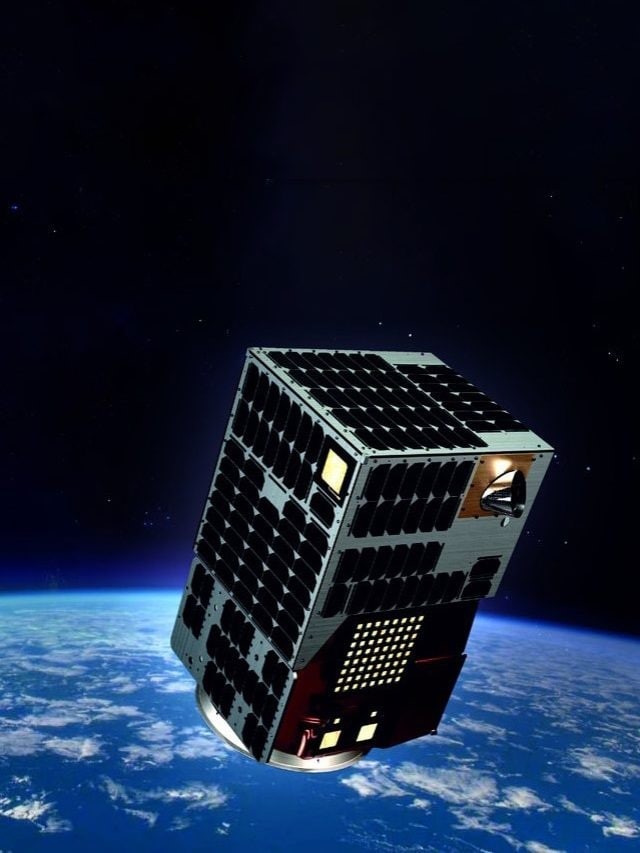Description

Source: Business Today
Disclaimer: Copyright infringement not intended.
Context
- TASL announces successful deployment of sub-metre resolution optical satellite TSAT-1A.
Details
Satellite Deployment
- Launch Vehicle: SpaceX's Falcon 9 rocket
- Mission Name: Bandwagon-1
- Collaboration:
- TASL collaborated with Satellogic, leveraging the latter's expertise in developing and integrating advanced earth observation satellites.
- The collaboration was initiated in November 2023 to develop and integrate TSAT-1A, showcasing TASL's capability in complex system integration.
Satellite Capabilities
- High-Resolution Imaging: TSAT-1A is capable of delivering high-resolution optical satellite images with sub-metre resolution.
- Increased Collection Capacity: The satellite features enhanced collection capacity, enabling it to capture a wide range of imagery.
- Multispectral and Hyperspectral Capabilities: TSAT-1A is equipped with multispectral and hyperspectral capabilities for advanced imaging.
Manufacturing
- TSAT-1A was assembled at TASL's Assembly, Integration, and Testing plant located at its Vemagal facility in Karnataka, India.
- This milestone demonstrates TASL's commitment to the space sector and showcases India's capabilities in satellite manufacturing and integration.

Bandwagon-1 Mission
- SpaceX's Bandwagon-1 mission marks the first dedicated rideshare mission launched into a mid-inclination orbit, offering a higher revisit rate for customers.
- In addition to TSAT-1A, the mission included 11 other spacecraft from various organizations, further expanding the capabilities of space exploration and observation.
About Satellites
- Satellites are artificial objects placed into orbit around celestial bodies, primarily Earth, for various purposes, including communication, navigation, Earth observation, scientific research, and national security.
- They play a crucial role in modern-day communication, weather forecasting, disaster management, and surveillance.
General Components of a Satellite:
- Power Source: Solar panels for power requirements.
- Housing: Protection for critical instruments.
- Transponders: Transmit and amplify radio signals.
- Thermal Control: Maintain equipment temperature.
- Command and Data Handling: Control and monitor satellite functions.
- Guidance and Stabilization: Maintain orbit and orientation.
Types of Satellites:
Communication Satellites:
- Purpose: Facilitate communication by transmitting signals between ground stations and receivers.
- Examples:
- Intelsat: Provides global communication services.
- Iridium: Offers satellite phone and data services worldwide.
Navigation Satellites:
- Purpose: Provide precise positioning and timing information for navigation purposes.
- Examples:
- Global Positioning System (GPS): Maintained by the U.S. Department of Defense for worldwide navigation.
- Galileo: European Union's global navigation satellite system.
Earth Observation Satellites:
- Purpose: Capture high-resolution images of Earth's surface for various applications, including environmental monitoring, agriculture, urban planning, and disaster management.
- Examples:
- Landsat: Provides multispectral imagery for monitoring changes in land use and environmental conditions.
- Sentinel series: Part of the European Space Agency's Copernicus program for environmental monitoring.
Weather Satellites:
- Purpose: Monitor atmospheric conditions, track weather patterns, and forecast weather events.
- Examples:
- GOES (Geostationary Operational Environmental Satellites): Operated by NOAA for weather monitoring and forecasting in the U.S.
- Meteosat: European weather satellites operated by EUMETSAT.
Reconnaissance Satellites:
- Purpose: Gather intelligence and perform surveillance for military and security purposes.
- Examples:
- Keyhole series (KH): Used by the U.S. National Reconnaissance Office (NRO) for reconnaissance missions.
- Lacrosse series: Radar imaging reconnaissance satellites operated by the NRO.
Scientific Satellites:
- Purpose: Conduct scientific research and experiments in space, studying celestial bodies, cosmic phenomena, and space environment.
- Examples:
- Hubble Space Telescope: Observes distant galaxies, stars, and planets, providing valuable insights into the universe.
- Chandra X-ray Observatory: Studies X-ray emissions from celestial objects, including black holes and supernovae.
Navigation and Research Satellites:
- Purpose: Combine navigation and scientific research capabilities for various applications.
- Examples:
- BeiDou Navigation Satellite System (BDS): Provides navigation services while supporting scientific research activities.
- International Space Station (ISS): Serves as a research laboratory for conducting experiments in microgravity.
Orbits of Different Satellite Types:
- Communication Satellites: GEO for telecommunication, LEO for high-speed internet.
- Earth Observation Satellites: Synchronous sub-recurrent orbit for continuous monitoring.
- Navigation Satellites: MEO for GPS, Geostationary orbits for NavIC.
- Astronomical Satellites: Low Earth orbit for Hubble Space Telescope, unique orbits for James Webb Space Telescope.
Must Read Articles:
Space X
Sources:
Hindu
|
PRACTICE QUESTION
Q. Satellites play diverse and vital roles in modern society, from facilitating global communication to enabling precise navigation and monitoring Earth's environment. Substantiate. (250 Words)
|
















